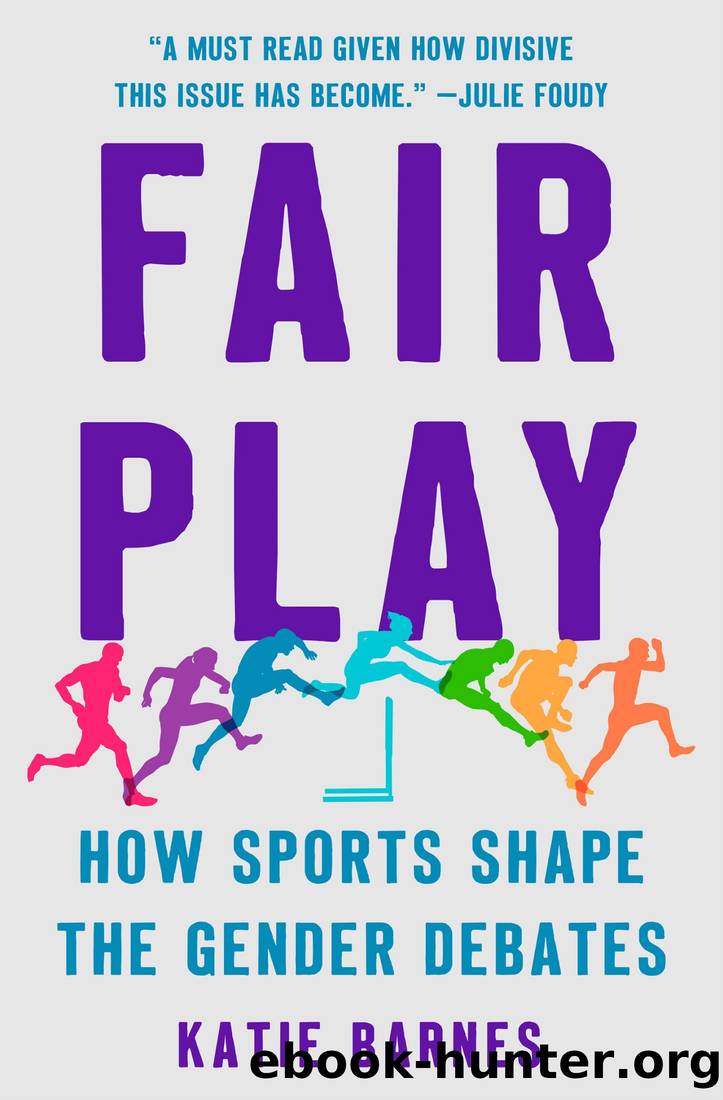Fair Play by Katie Barnes

Author:Katie Barnes [Barnes, Katie]
Language: eng
Format: epub
Publisher: St. Martin's Publishing Group
* * *
NANCY HOGSHEAD-MAKAR USED to agree with her former colleagues at the Womenâs Sports Foundation. She was the advocacy director when she published a position paper on behalf of WSF alongside fellow Title IX expert Erin Buzuvis that argued for the full inclusion of intersex athletes in womenâs sports.2 âIâm pretty sure itâs still up there,â she said to me over Zoom from her fuchsia-walled study. âBut I felt a little uncomfortable because those of us who have been involved in elite sports know how big the gap is between boys and girls, men and women.â
The gap she was referring to in this case was the often cited 10 to 12 percent performance gap between elite male and elite female athletes, which is seen as a direct result of testosterone-driven puberty, which gives those assigned male at birth considerable advantages in terms of speed and strength. It was a gap Hogshead-Makar said she witnessed herself in the years she spent in the pool as an elite athlete growing up in Florida. She became world class at the age of fourteen and by eighteen had qualified for the 1980 Olympics, though she never competed due to the United Statesâ boycott of the games. She did compete in the 1984 Olympics in Los Angeles, where she became the most decorated swimmer at the games, with three gold medals and one silver. She spent hours in the pool and often was the only woman. âIn my whole career, I probably only trained with maybe three or four women,â Hogshead-Makar said. âI was between ten and fourteen percent slower than my male competitors. I had a phenomenal diet. I had excellent coaching. I had access to weight rooms. I had everything the male athletes had, and I was still much slower than they were, starting in high school.â
Coleman agreed. âThose of us who are athletes know that the separation on the basis of sex is necessary to achieve equality in this space.â There is an uncomfortable kernel of truth to Hogshead-Makarâs and Colemanâs positions. That doesnât mean that theyâre the only thing that matters. In Hogshead-Makarâs experience as an elite athlete in the 1980s, getting outswum by boys with less relative talent was essential to the perspective she brought to her work as a lawyer fighting for the equal treatment of women under Title IX. That experience is also something Hogshead-Makar regularly cited as a driving force behind her advocacy of protecting womenâs sports from transgender women competing with what she saw as an unfair advantage. For those who disagree with the policy positions of Hogshead-Makar and Coleman, the lens through which they view the topic of transgender inclusion in sports and Title IX is different. Instead of approaching it through an elite competitive lens, they look at it through one driven more by participation. â[The debate about transgender athletes] seems to really bring up a lot of emotions and personal experiences for some Olympic athletes who have dealt with other situations,â National Womenâs Law Center General Counsel Neena Chaudhry said.
Download
This site does not store any files on its server. We only index and link to content provided by other sites. Please contact the content providers to delete copyright contents if any and email us, we'll remove relevant links or contents immediately.
Unstoppable by Maria Sharapova(3124)
The Inner Game of Tennis by W. Timothy Gallwey(3009)
Urban Outlaw by Magnus Walker(2953)
Crazy Is My Superpower by A.J. Mendez Brooks(2873)
The Social Psychology of Inequality by Unknown(2322)
The Fight by Norman Mailer(2164)
Unstoppable: My Life So Far by Maria Sharapova(2133)
Going Long by Editors of Runner's World(1927)
Accepted by Pat Patterson(1922)
Motorcycle Man by Kristen Ashley(1870)
The Happy Runner by David Roche(1832)
The Sports Gene: Inside the Science of Extraordinary Athletic Performance by David Epstein(1827)
Backpacker the Complete Guide to Backpacking by Backpacker Magazine(1827)
Futebol by Alex Bellos(1807)
Sea Survival Handbook by Keith Colwell(1800)
Mind Fuck by Manna Francis(1753)
Peak: Secrets from the New Science of Expertise by Anders Ericsson & Robert Pool(1667)
Endure by Alex Hutchinson(1614)
The Call of Everest by Conrad Anker(1555)
